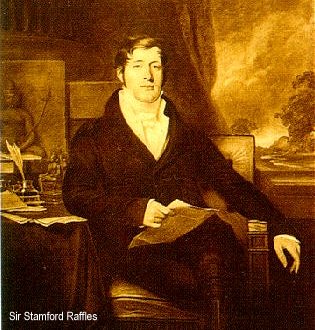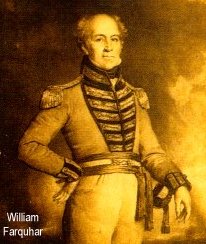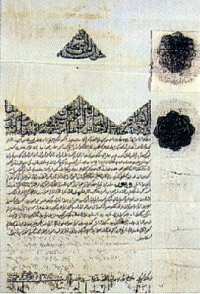|
|
Singapore
From den of pirates to port city
 Stamford
Raffles was the son of a sea-captain and had been born on his father's
ship off Jamaica in 1781. His family was poor, and after very little
schooling he became a clerk in the East India Company's office in
London at the age of fourteen. There he worked so hard that he won the
esteem of his employers and at the same time managed to continue his
education during his leisure hours. His chance came in 1805, when
Penang was made a Presidency and he was appointed Assistant Secretary
to the Government there. On the long voyage to the East Raffles set
himself to learn all he could of the language and history of the Malay
people among whom he was to work. Soon after his arrival at Penang this
knowledge led to his being employed as the official Malay translator,
and in 1807 he was promoted to the post of Secretary to the Government. Stamford
Raffles was the son of a sea-captain and had been born on his father's
ship off Jamaica in 1781. His family was poor, and after very little
schooling he became a clerk in the East India Company's office in
London at the age of fourteen. There he worked so hard that he won the
esteem of his employers and at the same time managed to continue his
education during his leisure hours. His chance came in 1805, when
Penang was made a Presidency and he was appointed Assistant Secretary
to the Government there. On the long voyage to the East Raffles set
himself to learn all he could of the language and history of the Malay
people among whom he was to work. Soon after his arrival at Penang this
knowledge led to his being employed as the official Malay translator,
and in 1807 he was promoted to the post of Secretary to the Government.
 By
this time, the Napoleonic Wars were in full swing and the Dutch in Java
began collaborating with their French allies in Mauritius in denying
Britain naval supremacy and trade in the East. Britain was compelled to
capture both islands. Mauritius was captured in 1810 and a great
invasion task force came to Penang the next year. From Penang, it moved
down to Melaka where Raffles had been organising an intelligence unit;
and then it crossed to Java, which was quickly captured. By
this time, the Napoleonic Wars were in full swing and the Dutch in Java
began collaborating with their French allies in Mauritius in denying
Britain naval supremacy and trade in the East. Britain was compelled to
capture both islands. Mauritius was captured in 1810 and a great
invasion task force came to Penang the next year. From Penang, it moved
down to Melaka where Raffles had been organising an intelligence unit;
and then it crossed to Java, which was quickly captured.
When the war ended in Europe, the British wanted a powerful
Holland in Europe to act as a buffer between it and France, and so Java
was restored to it. Raffles, however, loathed the Dutch administration
in the East and firmly believed it was in Britain's greatest to retain
Holland's eastern possessions. He was furious but could do nothing.
However, he was saved by his enemies, the Dutch. On their return to
Java, they re-imposed, with greater effectiveness than before, their
old regulations and trade restrictions.
 In
late 1818, he was instructed by the authorities in India to see if he
could establish a British trading post at Riau, if this could be done
without a quarrel with the Dutch. He sailed to Penang and then on down
the Straits of Melaka. He took with him William Farquhar, who had been
in charge of Melaka during the war. He did not go to Riau, for the
Dutch had returned there and garrisoned it. He went instead to the
Carimon Islands nearby. Here, he found fresh water, but the harbour was
unsatisfactory. So he sailed from there to Singapore in January 1819,
landing at the mouth of the Singapore River on a beach littered with
skulls - it was then a den of Malay pirates. In
late 1818, he was instructed by the authorities in India to see if he
could establish a British trading post at Riau, if this could be done
without a quarrel with the Dutch. He sailed to Penang and then on down
the Straits of Melaka. He took with him William Farquhar, who had been
in charge of Melaka during the war. He did not go to Riau, for the
Dutch had returned there and garrisoned it. He went instead to the
Carimon Islands nearby. Here, he found fresh water, but the harbour was
unsatisfactory. So he sailed from there to Singapore in January 1819,
landing at the mouth of the Singapore River on a beach littered with
skulls - it was then a den of Malay pirates.
Raffles found a small village inhabited by about 150 Malays
and Orang Laut, who lived by fishing and piracy under the leadership of
the Temenggong of Johore, the actual ruler of that state, since the
Sultan was a mere puppet of the Bugis Raja Muda and the Dutch in Riau.
Raffles made an agreement with the Temenggong for the establishment of
a factory, but this needed confirmation by the Sultan. Major Farquhar
was sent to try to get this, but as was to be expected, the Raja Muda
and the Sultan were too much in the power of the Dutch to commit
themselves.
 Then
Raffles had another idea. When the late Sultan Mahmud died in 1810 his
eldest son, Tengku Long, was away in Pahang, where he was marrying the
Bendahara's sister. According to Malay custom, the heir to the throne
must take part in the funeral of his predecessor before being
installed. In the absence of Tengku Long, the Bugis Raja Muda had
installed his younger brother, Abdur-Rahman, although there is some
doubt whether this was legally done, because the regalia was still
retained by the wife of the late ruler, who supported the elder
brother's claims. In any case, Tengku Long was living as a penniless
pretender in Riau when two messengers sent by Raffles brought him to
Singapore, where he was received and recognized as the rightful Sultan
Hussein of Johore. A treaty was then made with the new Sultan and the
Temenggong by which they agreed to the East India Company establishing
a factory in return for payments Of $5,ooo a year for the former and
$3,000 for the latter. Then
Raffles had another idea. When the late Sultan Mahmud died in 1810 his
eldest son, Tengku Long, was away in Pahang, where he was marrying the
Bendahara's sister. According to Malay custom, the heir to the throne
must take part in the funeral of his predecessor before being
installed. In the absence of Tengku Long, the Bugis Raja Muda had
installed his younger brother, Abdur-Rahman, although there is some
doubt whether this was legally done, because the regalia was still
retained by the wife of the late ruler, who supported the elder
brother's claims. In any case, Tengku Long was living as a penniless
pretender in Riau when two messengers sent by Raffles brought him to
Singapore, where he was received and recognized as the rightful Sultan
Hussein of Johore. A treaty was then made with the new Sultan and the
Temenggong by which they agreed to the East India Company establishing
a factory in return for payments Of $5,ooo a year for the former and
$3,000 for the latter.
 In order to draw to
Singapore all the trade he could, Raffles declared that the port was to
be free and open to the ships of all nations, free of duty, equally and
alike for all. This was the foundation upon which Singapore built up
its great entrepot trade. Raffles hoped to make Singapore a centre of
learning as well as commerce, and laid the foundations of the "
Institution " now named after him. This was originally intended to be
the beginnings of a university where the languages and cultures of the
Malayan peoples could be studied. In order to draw to
Singapore all the trade he could, Raffles declared that the port was to
be free and open to the ships of all nations, free of duty, equally and
alike for all. This was the foundation upon which Singapore built up
its great entrepot trade. Raffles hoped to make Singapore a centre of
learning as well as commerce, and laid the foundations of the "
Institution " now named after him. This was originally intended to be
the beginnings of a university where the languages and cultures of the
Malayan peoples could be studied.
 Raffles then returned to
Bencoolen to wind up his affairs there before retiring to Britain. By
this time it was certain that Singapore would not be given up. Raffles
had achieved his object,. but at a terrible personal cost. His first
wife had died in Java, and three of his four children perished in the
unhealthy climate of Bencoolen. He returned to Britain old before his
time and weakened in health if not in spirit. As a crowning misfortune,
the ship in which he sailed was destroyed by fire, and most of the
collection of natural specimens and Malay manuscripts which he had
gathered together was lost. Even after he was in retirement, the East
India Company treated him meanly in money matters and gave him scant
thanks for his great work. In 1826 he died suddenly on the eve of his
forty-sixth birthday. Raffles then returned to
Bencoolen to wind up his affairs there before retiring to Britain. By
this time it was certain that Singapore would not be given up. Raffles
had achieved his object,. but at a terrible personal cost. His first
wife had died in Java, and three of his four children perished in the
unhealthy climate of Bencoolen. He returned to Britain old before his
time and weakened in health if not in spirit. As a crowning misfortune,
the ship in which he sailed was destroyed by fire, and most of the
collection of natural specimens and Malay manuscripts which he had
gathered together was lost. Even after he was in retirement, the East
India Company treated him meanly in money matters and gave him scant
thanks for his great work. In 1826 he died suddenly on the eve of his
forty-sixth birthday.
Write to the author: sabrizain@malaya.org.uk
The
Sejarah Melayu
website is
maintained solely by myself and does not receive any funding
support from any governmental, academic, corporate or other
organizations. If you have found the Sejarah Melayu website useful, any
financial contribution you can make, no matter how small, will be
deeply appreciated and assist greatly in the continued maintenance of
this site.
|
|

